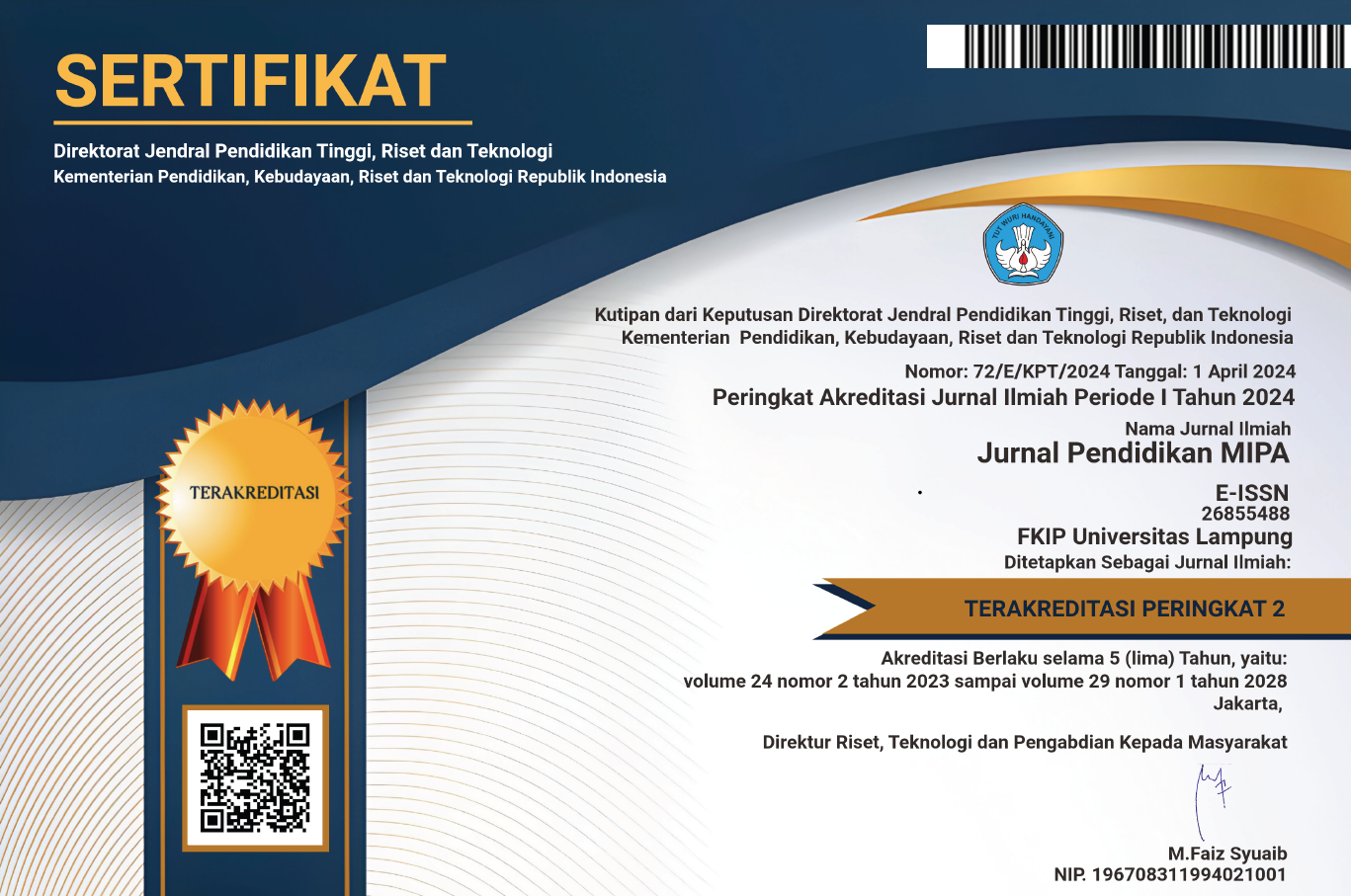Improving Students’ Problem Solving Skills and Laboratory Performance by Sublimation Apparatus Modification Project
 Country:
Country:
(1) Universitas Lampung, Indonesia
(2) Universitas Lampung, Indonesia
(3) Universitas Lampung, Indonesia
| Metrics→ |
| Indexing Site→ |
Copyright (c) 2025 Haritsah Ulya, Noor Fadiawati, Abdurrahman Abdurrahman
This study aims to develop a sublimation tool to improve problem solving skills and performance in the laboratory. The research method used is the Research and Development (R&D) method with a 4D model. The research sample consisted of control and experimental classes. The sampling technique used was purposive sampling. The results showed that the developed sublimation tool stated: (1) effective for use, it was obtained (1.64). In addition, the results of the development are also good in improving students' problem solving skills with n gain (0.64) with high criteria (2) the results of responses from students' responses to the attractiveness aspect (100%), readability aspect (96.29%), and tool design (100%). Based on the results of research and development, it can be stated that the developed sublimation tool is effective for improving problem solving skills and performance in the laboratory and can be used in practical experiments in studying the material for separating mixtures with sublimation techniques.
Keywords: development, sublimation, problem solving.
Abrahams, L., & Millar, R. (2008). Does practical work really work? A study of the effectiveness of practical work as a teaching and learning method in school science. International Journal of Science Education, 30(14), 1945–1969.
Alfalobi, F., & Akinbobola, A. O. (2010). Analysis of science process skills in West African senior secondary school certificate physics practical examinations in Nigeria. American-Eurasian Journal of Scientific Research, 5(4), 234–240.
Aksela, M., & Juntunen, M. (2013). Life-cycle analysis and inquiry-based learning in chemistry teaching. Science Education International, 24(2), 150–166.
Arimbawa, P., Sadia, I. W., & Tika, I. N. (2013). Pengaruh model pembelajaran berbasis proyek (MPBP) terhadap kemampuan pemecahan masalah IPA sehari-hari ditinjau dari motivasi berprestasi siswa. E-Journal Program Pascasarjana Universitas Pendidikan Ganesha, 3(1), 1–11.
Bell, S. (2010). Project based learning for the 21st century: Skills for the future. The Clearing House, 83, 39–43.
ChanLin, L.-J. (2008). Technology integration applied to project based learning in science. Innovation in Education and Teaching International, 45(1), 55–65.
Erdogan, M., Ozel, M., Usak, M., & Prokop, P. (2009). Development and validation of an instrument to measure university students’ biotechnology attitude. Journal of Science Education and Technology, 18(1), 255–264.
Fadiawati, N. (2013). Pengembangan perangkat pembelajaran kesetimbangan kimia berbasis representasi kimia untuk siswa kelas XI IPA. Prosiding Seminar Penelitian, Pendidikan, dan Penerapan MIPA, 197–203.
Fadiawati, N., & Tania, L. (2014). Efektivitas pendekatan saintifik dalam meningkatkan keterampilan berpikir kreatif siswa pada materi kesetimbangan kimia. Laporan Penelitian (tidak diterbitkan).
Fredricks, J., McColskey, W., Meli, J., Mordica, J., Montrosse, B., & Mooney, K. (2011). Measuring student engagement in upper elementary through high school: A description of 21 instruments (Issues and Answers Report No. 098).
Garnett, P. J., & Hacking, M. W. (1995). Refocusing the chemistry lab: A case for laboratory-based investigations. Australian Science Teachers Journal, 41(2), 26–32.
Glaser, R. E., & Carson, K. M. (2005). Chemistry is in the news: Taxonomy of authentic news media-based learning. International Journal of Science Education, 27(9), 1083–1098.
Hake, R. R. (1999). Interactive-engagement versus traditional methods: A six-thousand-student survey of mechanics tests data for introductory physics courses. American Journal of Physics, 66(1), 64–74.
Hayat, M. S., Anggraeni, S., & Redjeki, S. (2012). Pembelajaran berbasis praktikum pada konsep invertebrata untuk pengembangan sikap ilmiah siswa. Journal of Bioma, 1(2), 141–152.
Hofstein, A., & Lunetta, V. N. (2004). The laboratory in science education: Foundation for the twenty-first century. Science Education, 88(1), 28–55.
Keegan, S. N. (2007). Importance of visual image in lectures: Case study on tourism management students. Journal of Hospitality, Leisure, Sport & Tourism Education, 6(1), 58–65.
Lubis, J. N., Panjaitan, A., Surya, E., & Syahputra, E. (2017). Analysis of mathematical problem-solving skill of grade VIII-2 students at Bilah Hulu Junior High School. International Journal of Novel Research in Education and Learning, 4(2), 131–137.
Nurhadi. (2004). Pembelajaran kontekstual dan penerapannya dalam KBK. Malang: UM Press.
Phelps, A. J., & Lee, C. (2003). The power of practice: What students learn from how we teach. Journal of Science Education, 80(7), 829–832.
Polya, G. (1971). How to solve it (2nd ed.). Princeton, NJ: Princeton University Press.
Rezakazemi, M., Khajeh, H., & Mesbah, M. (2017). Membrane filtration of wastewater from gas and oil production. Environmental Chemistry Letters, 16(2), 367–388.
Sumarni, W. (2015). The strength and weakness of the implementation of project based learning: A review. International Journal of Science and Research, 4(3), 478–484.
Sumintono, B. I., Ibrahim, M. A., & Phang, F. A. (2010). Pengajaran sains dengan praktikum laboratorium: Perspektif dari guru-guru sains SMPN di Kota Cimahi. Jurnal Pengajaran MIPA, 15(2), 120–127.
Sundari, R. (2008). Evaluasi pemanfaatan laboratorium dalam pembelajaran biologi di Madrasah Aliyah Negeri se-Kabupaten Sleman. Jurnal Penelitian dan Evaluasi Pendidikan, 7(2), 1–4.
Thiagarajan, S., Semmel, D. S., & Semmel, M. I. (1974). Instructional development for training teachers of exceptional children. Indiana: Indiana University Bloomington.
Thomas, J. W. (2000). A review of research on project-based learning. International Journal of Research, 1(1), 1–46.
Wardani, D. L., Degeng, I. N. S., & Cholid, A. (2019). Developing interactive multimedia model 4D for teaching natural science subject. International Journal of Education and Research, 7(1), 63–72.
Widiyatmoko, A., & Pamelasari, S. D. (2015). Pembelajaran berbasis proyek untuk mengembangkan alat peraga IPA dengan memanfaatkan bahan bekas pakai. Jurnal Pendidikan IPA Indonesia, 1(1), 51–56.
Widowati, A. (2009). Pengembangan critical thinking melalui penerapan model PBL (Problem Based Learning) dalam pembelajaran sains. Prosiding Seminar Nasional Penelitian, Pendidikan, dan Penerapan MIPA, Universitas Negeri Yogyakarta.
Yaqin, I. R., Demeianto, B., Siahaan, J. P., Priharanto, Y. E., & Musa, I. (2019). Rancang bangun alat penjernih air portable untuk persediaan air di Kota Dumai. Jurnal Teknologi UMY, 12(3), 1–10.
Zhou, C. (2012). Integrating creativity training into problem and project-based learning curriculum in engineering education. European Journal of Engineering Education, 37(5), 488–499.
Refbacks
- There are currently no refbacks.

This work is licensed under a Creative Commons Attribution-ShareAlike 4.0 International License.


